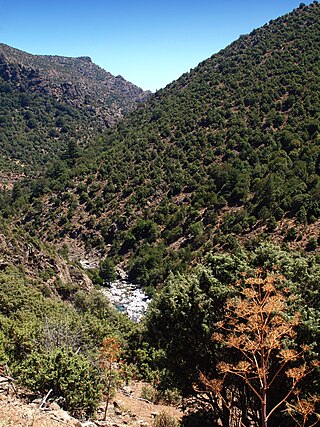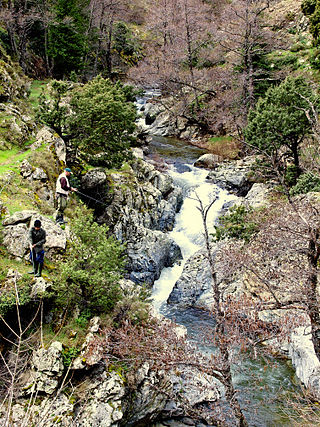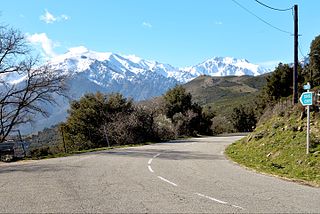
Aiti is a commune in the Haute-Corse department of France on the island of Corsica.

Afa a commune in the Corse-du-Sud department on the island and collectivity of Corsica, France.

Alata is a commune in the Corse-du-Sud department, on the French island of Corsica. It is within the metropolitan area of the capital Ajaccio.

Asco is a commune in the Haute-Corse department of France on the island of Corsica.

Barbaggio is a commune in the French department of Haute-Corse on the island of Corsica. It is known for its wine, its scenery, and the prehistoric site of Strette.

Morosaglia is a commune in the Haute-Corse department, on the island of Corsica, France. Since 2015, it is the seat of the canton of Golo-Morosaglia.
The Canton of Golo-Morosaglia is an administrative division of the Haute-Corse department, Corsica, France. It was created at the French canton reorganisation which came into effect in March 2015. Its seat is in Morosaglia.
Deux-Sevi is a region of Corsica, located on its west side in the province of Vico. It is also the name of the canton constituted by these communes. It is between Filiosorma and Deux-Sorru. In the Corsican language, the inhabitants are called Sivinchi. The territory also has multiple UNESCO world heritage sites.

Punta Artica or Monte Artica is a mountain in the department of Haute-Corse on the island of Corsica, France. It is in the Monte Rotondo massif.

The Capu Biancu is a mountain in the department of Haute-Corse on the island of Corsica, France.

The Monte Cinto massif is one of the main massifs in the island of Corsica, France, taking its name from the highest mountain in Corsica, Monte Cinto. It is the northernmost and highest of the four massifs that form the spine of the island. The massif is mostly in the Haute-Corse department, but the southwest of the massif is in the Corse-du-Sud department.

The Col de Bigorno Corsican: Bocca di Bigornu), or Bigorno Pass, is a mountain pass in the Haute-Corse department of Corsica, France.

Lac de Calacuccia is a reservoir in the Haute-Corse department of France formed by damming the Golo river. It provides hydroelectric power and water for irrigation in the dry season.

The Asco is a small river in the department of Haute-Corse, Corsica, France. It is a tributary of the Golo. The river rises in the Monte Cinto massif among some of the highest mountains of Corsica, passes a ski resort and the old village of Asco and cuts through a dramatic 4 kilometres (2.5 mi) gorge before joining the Golo.

The Fango is a small coastal river in the department of Haute-Corse, Corsica, France. The Fango Valley was designated a biosphere reserve in 1977. It holds flora and fauna representative of all regions of Corsica from the coast to the highest mountains.

The Erco is a stream in the department of Haute-Corse, Corsica, France. It is a tributary of the Golo.

Capo al Berdato is a mountain in the department of Haute-Corse on the island of Corsica, France. It is in the Monte Cinto massif.

Punta Minuta is a 2,556 metres (8,386 ft) mountain in the department of Haute-Corse on the island of Corsica, France. It is in the Monte Cinto massif.

The Paglia Orba is a mountain peak in the Monte Cinto massif in Corsica. It rises to an altitude of 2,525 metres (8,284 ft), between the valleys of the Golo and the Cavicchia. Relatively isolated, this peak, notable for its characteristic tooth-shaped silhouette, dominates the Fango Valley and the west coast of the island.

The Col de San Quilico or collo di San Quilico is a mountain pass in the Haute-Corse department of Corsica, France. It is a road pass on Territorial Route 20, between Corte and Ponte Leccia (Morosaglia).







































